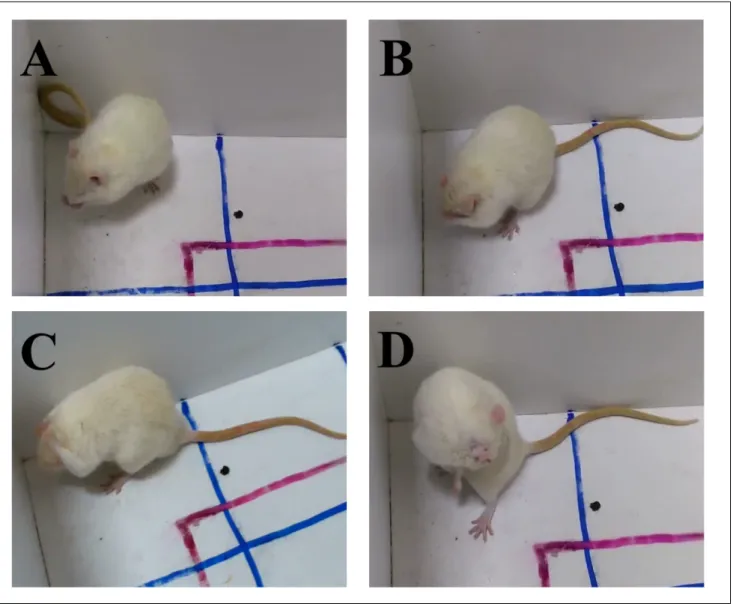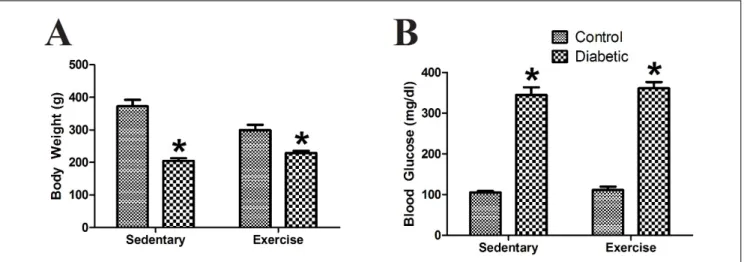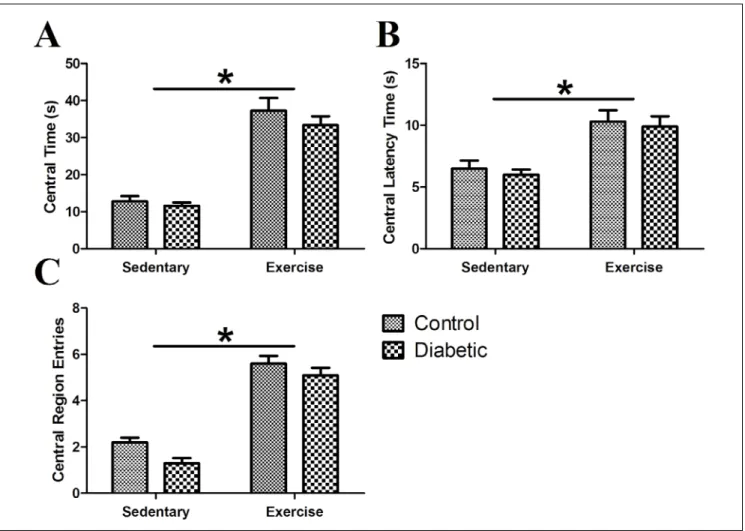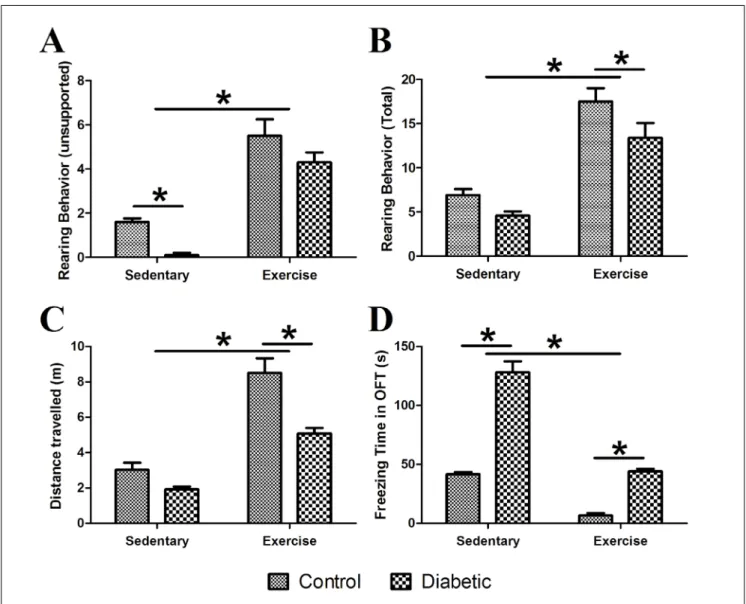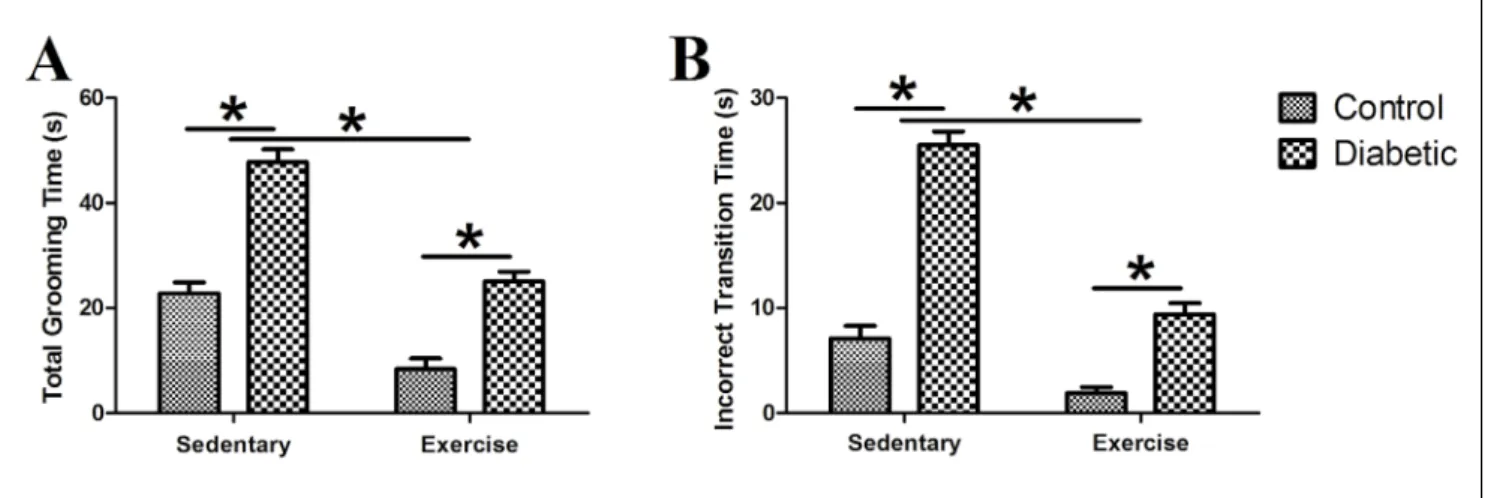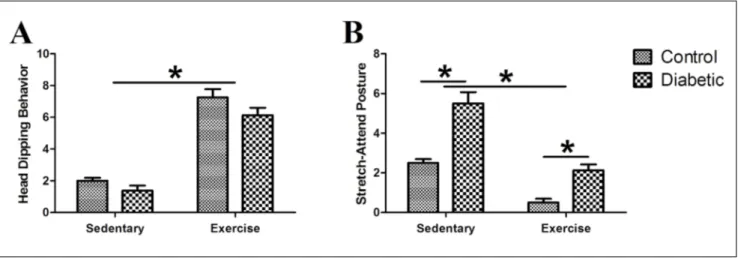© 2020 by Acta Neur
obiologiae Experimentalis
Aerobic exercise has an anxiolytic effect on
streptozotocin‑induced diabetic rats
Hasan Caliskan1,2, Firat Akat1*,Goktug Omercioglu1,Gulbahar Bastug3, Hakan Ficicilar1 and Metin Bastug1
1 Ankara University, Faculty of Medicine, Department of Physiology, Ankara, Turkey, 2 Balikesir University, Faculty of Medicine,
Department of Physiology, Balikesir, Turkey, 3 Ankara University, Vocational School of Health Services, Ankara, Turkey,
*Email: Firat.Akat@ankara.edu.tr; akatfirat@gmail.com
Diabetes is a metabolic disorder characterized by hyperglycemia and impaired insulin secretion or action. Psychological comorbidities, such as depression and anxiety, are more common in people with diabetes. Exercise results in anxiolytic effects, as demonstrated in numerous studies. This study aims to evaluate potential anxiolytic effects of aerobic exercise in streptozotocin (STZ)‑induced diabetes. Male Wistar albino rats (n=40) were randomly divided into four groups of control, exercise, diabetes, and diabetes + exercise. Diabetes was induced with a single i.p. injection of STZ. The incremental load test was applied to exercise groups to determine maximal exercise capacity. Rats exercised on a treadmill at 70% of their maximal capacity for 45 min, five days per week for 12 weeks. On the day after the last exercise session the open field test and elevated plus maze test were carried out. Diabetes caused an increase in anxiety level, reflected in stretch‑attend posture, self‑grooming behaviors, and freezing time, with no significant changes for other behavioral parameters. Training normalized diabetes‑induced deteriorations and also induced a significant anxiolytic effect both on diabetic and non‑diabetic rats. This effect was observed for all behavioral parameters. The results of the open field test and elevated plus maze were consistent. The current results demonstrated a slight increase in anxiety with diabetes and a prominent anxiolytic effect of aerobic exercise. Considering the conflicting results in exercise‑anxiety studies, this study highlights the importance of individually designed exercise protocols.
Key words: exercise, diabetes, anxiety, open field test, elevated plus maze
INTRODUCTION
Diabetes mellitus is a metabolic disorder that man‑ ifests itself with chronic hyperglycemia and partial or complete loss of insulin secretion (American Diabetes Association, 2010). Today, diabetes has spiked to an ep‑ idemic level worldwide (Tabish, 2007). Wild et al. (2004) reported that the prevalence of diabetes was 2.8% in 2000 and is expected to rise to 4.4% by 2030. Therefore, the current 171 million diabetics around the globe may increase to 366 million by the year 2030.
Diabetes has many complications including car‑ diomyopathy, retinopathy, neuropathy, nephropathy, as well as affecting the mental status of the patients. Various psychological comorbidities, such as depres‑
sion and anxiety, are associated with diabetes (Duc‑ at et al., 2014) and the prognosis is worse in patients with poor glycemic control (Lustman et al., 2000). In addition to clinical studies, behavioral alterations were demonstrated in experimental models in different spe‑ cies. Streptozotocin (STZ) is the most common drug used in experimental diabetes (Radenkovic et al., 2016). STZ‑induced diabetes aggravates anxiety‑like behav‑ iors (ALB) (Thorre et al., 1997; Aksu et al., 2012; Tang et al., 2015; Rajashree et al., 2017; Aswar et al., 2017; Pereira et al., 2018; Rahmani et al., 2018; Rajabi et al., 2018), depression‑like behaviors (DLB) (da Silva Haeser et al., 2007; Gupta et al., 2014; Aswar et al., 2017; Re‑ bolledo‑Solleiro and Fernandez‑Guasti, 2018), and cog‑ nitive deficits (CD) (Zhou et al., 2015; Sun et al., 2017; Gocmez et al., 2019) in rodents. Hilakivi‑Clarke et al.
Received 28 December 2019, accepted 23 April 2020
Acta Neurobiol Exp 2020, 80 DOI: 10.21307/ane‑2020‑022
(1990) reported that male (Swiss NIH) diabetic mice ex‑ hibited less social interaction and more aggressive be‑ haviors in the resident‑intruder test. It was also shown that diabetic mice displayed increased repetitive and compulsive‑like behaviors in the marble‑burying test (Phadnis et al., 2018). Our group recently reported that eight weeks of STZ‑induced diabetes in female Wistar rats induced anxiety‑like behavior in some behaviors (Caliskan et al., 2019).
Exercise has numerous beneficial effects on human health (Farrell et al., 2011), including a positive effect on the mood of the individual (Taylor et al., 1985). Ligtenberg et al. (1998) demonstrated that aerobic training reduced anxiety measures in patients with type 2 diabetes. This notion has also been supported by various behavioral studies in animals, which re‑ ported training protocols that induced an anxiolytic effect in rodents (Ke et al., 2011; Tchekalarova et al., 2015; Ghodrati‑Jaldbakhan et al., 2017). On the other hand, some studies failed to demonstrate the anxio‑ lytic effect of exercise training (Chaouloff, 1994; Hoff‑ man et al., 2015; Georgieva et al., 2017), as well as Fuss et al. (2010a; 2010b), which reported a contrary result suggesting an anxiogenic effect of exercise training. These contradictory results primarily originate from differences in type, intensity, and duration of exercise between protocols. Thus, we placed particular em‑ phasis on determining the maximal exercise capacity of each animal and tailoring the individual training program according to the percentage of their maximal exercise capacity.
In the current study, we hypothesized that STZ‑in‑ duced diabetes will increase ALB and exercise training will ameliorate the anxiogenic effect of STZ‑induced di‑ abetes. There are few studies in the literature about dia‑ betes and exercise, and our study is the first that uses an individual training program in diabetic animals.
METHODS
Animals and ethical approvalAdult (10 weeks old) male Wistar albino (Rattus nor‑
vegicus) rats (n=40) were procured from Ankara Uni‑ versity Experimental Animals Breeding and Research Laboratory. Rats were adapted to our laboratory for one week before the start of the experiments. All rats had access to ad libitum chow and tap water and were kept on a 12h light/dark cycle, at constant temperature (21‑25˚C) and humidity (50‑55%). All the rats were han‑ dled in accordance with the Guide for the Care and Use of Laboratory Animals published by the US National In‑ stitutes of Health (NIH publication No. 85‑23, revised
1996). The protocol is approved by the Committee on the Local Ethics of Animal Experiments of Ankara Uni‑ versity (No: 2017‑04‑25).
Experimental design and induction of type I diabetes
Rats were randomly divided into four groups of Control (C; n=10), Exercise (EX; n=10), Diabetes (DM; n=10), and Diabetes + Exercise (DM+EX; n=10). At the end of 11th week, streptozotocin (STZ) (Sigma‑Aldrich,
Missouri, USA, S0130‑1G) dissolved in 0.1 M citrate buffer (pH 4.5) was administered i.p. (50 mg/kg) to rats in DM and DM+EX groups. Blood glucose levels were measured 24 hours and seven days after injec‑ tion and levels ≥300 mg/dl (16.6 mmol/L) was con‑ sidered diabetic. Animal body weights and blood glu‑ cose levels were monitored regularly throughout the study. Blood glucose was measured from the tail vein with a glucometer (On Call Plus, ACON Laboratories). Non‑diabetic rats’ blood glucose levels were also mea‑ sured initially to prove that they were non‑diabetic (Data not shown).
Incremental load test and exercise protocol
The rats in the exercise groups (EX and DM+EX) were adapted to treadmill running for a week. The DM+EX group was introduced to the training program after diagnosis of diabetes (7th day after STZ injec‑
tion), according to their incremental load test (pre‑ viously described in Teixeira et al., 2012). Briefly, rats started to exercise on the treadmill with a low work‑ load (5 m/min and 0˚). Speed was increased by 3m/ min, or slope was increased by 2˚ every 3 minutes. The workload at which the animal was not able to continue further, even in the presence of electrical or mechani‑ cal stimulation, was accepted as the animal’s maximal workload.
Rats began training at 70% of their maximal work‑ load. The incremental load test was repeated at the third, sixth, and ninth weeks and the training program was modified according to these results to ensure a 70% intensity throughout the training period. In order to al‑ ter exercise intensity, the running speed of the treadmill was increased or decreased while the slope was fixed to 10° for all rats throughout the training program.
Rats were exercised on the treadmill for 45 minutes at the specified workload five days a week for 12 weeks. A 7.5‑minute warm‑up period in which the speed and slope were gradually increased was applied before reaching the target speed and slope. A 7.5‑minute
cool‑down period was also applied after the completion of the exercise session.
Behavioral tests
Both behavioral tests were carried out in the early morning (09:00‑12:00) on the day after the final exer‑ cise session. The open field test (OFT) always preced‑ ed elevated plus maze (EPM), and there was no break between tests. The test room was kept silent under consistent light (110 lux, warm light). The observer re‑ mained outside during the test session. A hidden cam‑ era recorded the entire test, and the tapes were ana‑ lyzed blindly. Test setups were cleaned with 70% etha‑
nol after each animal to prevent an effect of odors left by another animal.
Open field test
The OFT was carried out as previously described (Caliskan et al., 2019). Briefly, we performed the test in a 100 × 100 × 40 cm hypethral box. The base was di‑ vided into 25 equal squares. The squares adjacent to the edges of the box were defined as the peripheral region, and the squares in the middle of the box were defined as the central region. Rats were always started in the central region. The first 5 min of the recording was used for the analysis. The behavioral parameters
Fig. 1. Cephalocaudal transition of self‑grooming behavior in rats. (A) Phase 1: elliptical bilateral paw strokes made near the nose (paw and nose grooming) (B) Phase 2: series of unilateral strokes (each made by one paw) from whiskers to below the eye (face grooming) (C) Phase 3: bilateral strokes backwards and upwards made by both paws simultaneously (head grooming) (D) Phase 4: body licking (body grooming) (Kalueff et al., 2016).
assessed were total time in the central region, i.e., cen‑ tral time; the time spent before leaving the central re‑ gion, i.e., central latency time; the number of entries into the central region, i.e., central region entries; freezing time; total distance traveled; unsupported rearing behavior; and total (unsupported + supported) rearing behavior.
Additionally, we evaluated the self‑grooming be‑ haviors of the rats in the OFT (Fig. 1). Self‑grooming in rats shows a high level of behavioral complexity and organization, which involves a series of highly stereo‑ typed patterns (Kalueff et al., 2016). Acute stressors (for example, exposure to a new environment) increase the frequency and duration of self‑grooming behavior (Delprato et al., 2017; Zhang et al., 2019). Additionally, stressors result in a disorganized grooming pattern (i.e., incorrect transition) (Spruijt et al., 1987; 1992), whereas anxiolytic treatments tend to reduce rodent self‑groom‑ ing activity and normalize its sequential organization (Kalueff and Tuohimaa, 2005; Nin et al., 2012). To evalu‑ ate self‑grooming behavior, we assessed total grooming time and incorrect transition parameters.
Elevated plus maze
EPM was carried out as previously described (Cal‑ iskan et al., 2019). Briefly, we performed the test in a plus‑shaped maze which consisted of two open and two closed arms at a specific height (70 cm). Rats were started in the middle of the open arm. The first 5 min of the recording was used for analysis. The behavioral parameters analyzed were time spent on the open arms (total and distal portion: distal half of the open arm), the number of entries to the open arms, freezing time,
and the number of total head‑dipping behaviors and stretch‑attend postures (SAP).
Statistical analysis
The statistical analyses were performed using GraphPad Prism for Windows v5 2007 (GraphPad Soft‑ ware Inc.) software. Shapiro‑Wilk test was applied to all groups for all parameters to determine normal distribution. Data sets were distributed normally and other parametric test assumptions were met so a para‑ metric test was chosen for statistical analysis. We used two‑way ANOVA in a 2 × 2 (sedentary/exercise × diabet‑ ic/non‑diabetic) factorial design. Bonferroni test was preferred for post‑hoc comparisons. The values were presented as mean ± SE. For all comparisons, p<0.05 was considered to be significant.
RESULTS
Animal‑follow parametersThe body weight and blood glucose levels of the rats were measured before sacrificing (data shown in Fig. 2). Terminal body weight and blood glucose levels rats did not differ significantly between sedentary and exercis‑ ing rats (F(1,25)=2.59, p>0.05; F(1,24)=0.90, p>0.05, respec‑
tively). The body weight of diabetic rats was signifi‑ cantly lower and the blood glucose of the diabetic rats was significantly higher compared to their non‑diabet‑ ic matches (F(1,25)=63.50, p<0.001; F(1,24)=430.50, p<0.001,
respectively). This difference was observed both in sedentary and exercising pairs (p<0.01). The interac‑
Fig. 2. Animal‑follow parameters (A) Terminal body weight (C=7; EX=9; DM=6; DM+EX=7) (B) Terminal blood glucose level of rats (C=7; EX=9; DM=6; DM+EX=6) (*: p<0.05; X±SE).
tion between diabetes and exercise was significant for body weight (F(1,25)=10.62, p<0.01) but not significant for
blood glucose (F(1,24)=0.18, p>0.05).
The initial exercise capacity of the rats did not dif‑ fer among groups (p>0.05). Training increased the ex‑ ercise capacity of both diabetic and non‑diabetic rats, but this increase was not significant (p>0.05). The run‑ ning speed of the diabetic rats was lower compared to non‑diabetics but did not reach significance (p>0.05).
Open field test
Conventional OFT parameters are shown in Fig. 3. According to statistical analysis, the conventional OFT parameters of central time, central latency time, and central region entries were significantly higher in ex‑ ercising rats compared to sedentary rats (F(1,36)=106.10,
p<0.001; F(1,36)=27.58, p<0.001; F(1,36)=172.80, p<0.001, re‑
spectively). The effect of diabetes on these same pa‑ rameters also varied (F(1,36)=1.29, p>0.05; F(1,36)=0.38,
p>0.05; F(1,36)=6.53, p<0.05, respectively). Although the
effect of diabetes was significant for central the entry parameter, no significant differences were observed in all pairwise comparisons (C vs. DM+EX). Finally, the in‑ teraction between exercise and diabetes was not sig‑ nificant for central time, central latency time, or cen‑ tral region entries (F(1,36)=0.36, p>0.05; F(1,36)=0.01, p>0.05;
F(1,36)=0.53, p>0.05, respectively).
Parameters that evaluated the quiescence and lo‑ comotion of the rats in the OFT are shown in Fig. 4. Two‑way ANOVA analysis revealed that unsupport‑ ed rearing behavior, total rearing behavior, and dis‑ tance traveled were markedly higher in exercising rats compared to sedentary rats (F(1,36)=82.13, p<0.001;
F(1,36)=65.62, p<0.001; F(1,36)=75.99, p<0.001, respectively).
Furthermore, freezing was significantly lower in exer‑ cising rats compared to sedentary rats (F(1,36)=140.70,
p<0.001). There was a significant effect of diabetes on unsupported rearing behavior, total rearing behavior, and distance traveled (F(1,36)=9.13, p<0.01; F(1,36)=7.14,
p<0.05; F(1,36)=20.80, p<0.001; F(1,36)=152.80, p<0.001, re‑
Fig. 3. Conventional OFT parameters (A) Time spent in central region. Central time. (B) Time spent before the first entry to central region. Central latency time. (C) Total number of entries to the central region. Central region entries (*: p<0.05; X±SE).
spectively). Unsupported rearing behavior was sig‑ nificantly lower in sedentary diabetic rats compared to their non‑diabetic pairs (p<0.05). Total rearing be‑ havior and distance traveled were significantly lower in exercising diabetic rats compared to non‑diabetics (p<0.05; p<0.001, respectively). Freezing time was high‑ er both in exercising and sedentary diabetic rats com‑ pared to their matched controls (p<0.001).
The interaction of diabetes and exercise was not sig‑ nificant for unsupported and total rearing behaviors (F(1,36)=0.11, p>0.05; F(1,36)=0.56, p>0.05, respectively) but
was significant for distance traveled and freezing pa‑ rameters (F(1,36)=5.48, p<0.05; F(1,36)=23.86, p<0.001).
Self‑grooming parameters are shown in Fig. 5. All self‑grooming parameters (total grooming time and incorrect transition time) were markedly lower in ex‑ ercising rats compared to sedentary rats (F(1,36)=77.67,
p<0.001; F(1,36)=98.46, p<0.001, respectively) and high‑
er in diabetic rats (F(1,36)=97.13, p<0.001; F(1,36)=145.60,
p<0.001, respectively) compared to non‑diabetic rats. The interaction between diabetes and exercise was not significant for total grooming time (F(1,36)=3.96,
p>0.05) but was significant for incorrect transition time (F(1,36)=25.78, p<0.001).
Elevated plus maze
Conventional EPM parameters are shown in Fig. 6. Conventional EPM parameters of total open arm time, distal open arm time, and open arm entries were dra‑ matically higher in exercising rats compared to sed‑ entary rats (F(1,36)=96.55, p<0.001; F(1,36)=146.30, p<0.001;
F(1,36)=80.38, p<0.001, respectively). Diabetes effected
Fig. 4. Parameters that evaluate the quiescence and locomotion of animal in OFT. (A) Unsupported rearing behavior (B) Total rearing behavior (C) Distance traveled (D) Freezing time (*: p<0.05; X±SE).
distal open arm time markedly (F(1,36)=18.74, p<0.001)
but did not affect total open arm time and open arm entries (F(1,36) =2.90, p>0.05; F(1,36)=0.55, p>0.05, respec‑
tively). Distal open arm time was significantly lower
in diabetic exercising rats compared to their non‑dia‑ betic pair (p<0.001). The interaction between exercise and diabetes was significant for distal open arm time (F(1,36)=4.63, p<0.05) but was not significant for total arm
Fig. 6. Conventional EPM parameters. (A) Time spent in open arm. Total open arm time (B) Time spent in distal portion of the open arm. Distal open arm time. (C) Total entries to the open arm. (*: p<0.05; X±SE).
time and open arm entries (F(1,36)=1.05, p>0.05; F(1,36)=0.55,
p>0.05, respectively).
Additional EPM parameters are shown in Fig. 7. Ex‑ ercising rats showed more head‑dipping and less SAP behavior compared to sedentary rats (F(1,28)=154.50,
p<0.001; F(1,28)=60.20, p<0.001, respectively). Diabetes
markedly decrease head‑dipping behavior (F(1,28)=4.73,
p<0.05) and markedly increased SAP (F(1,28)=44.57,
p<0.001). Although the effect of diabetes was signifi‑ cant for head‑dipping behavior, no significant differ‑ ences were observed in paired comparisons (p>0.05). Regarding SAP, there was a significant difference be‑ tween both sedentary and exercising diabetics and their matched controls (p<0.01). The interaction be‑ tween exercise and diabetes was significant neither for head‑dipping nor SAP (F(1,28)=0.39, p>0.05; F(1,28)=3.94,
p>0.05, respectively).
DISCUSSION
According to the results, twelve weeks of aerobic ex‑ ercise evoked a potent anxiolytic effect on male Wistar rats. The anxiolytic effect was reflected in almost every behavioral parameter, both in diabetic and non‑diabet‑ ic rats. On the other hand, STZ‑induced diabetes caused a slight anxiogenic effect, which was only notable in SAP, freezing, and self‑grooming parameters.
Our training regimen lowered the bodyweight of rats, but the effect was not significant. Weight loss is typical in exercise training because of increased ener‑ gy expenditure; however, there was a significant inter‑ action between diabetes and exercise, which suggests that diabetic rats lose less weight with training com‑ pared to non‑diabetic runners. We speculate that dia‑ betes had already created a severe weight loss effect in these rats; therefore, exercise training did not cause
any further weight loss. Blood glucose levels were sig‑ nificantly higher in both diabetic groups compared to their non‑diabetic pairs, and training did not affect blood glucose levels in diabetic or non‑diabetic rats.
STZ‑induced experimental diabetes increases ALB in rodents. This phenomenon was demonstrated in various dose, strain, and diabetes duration models, in‑ cluding in both genders (Thorre et al., 1997; Aksu et al., 2012; Tang et al., 2015; Aswar et al., 2017; Rajashree et al., 2017; Rajabi et al., 2018; de Souza et al., 2019). Fur‑ thermore, our group recently reported a similar result. We used female Wistar albino rats, and the diabetes du‑ ration was six weeks. An anxiogenic effect was visible in head‑dipping behavior and SAP, but other parame‑ ters did not differ compared to the control (Caliskan et al., 2019). In the current study, the duration of diabetes was longer, and we used male rats instead of females; however, we only observed a slight anxiogenic effect, which was reflected in behavioral parameters such as SAP and self‑grooming behavior.
In general, stressors increase total grooming time and disrupt the sequential nature of self‑grooming be‑ havior (Kalueff et al., 2016). In rodents, there is a cor‑ rect sequence (a stereotyped order of movements) of self‑grooming behavior, which is called “cephalocaudal progression” (Fig. 1). Correct transition is defined as the total time of grooming that is executed in cephalocau‑ dal progression; thus, the incorrect transition is the pe‑ riod of irregular self‑grooming behavior (Kalueff et al., 2007). Anxiogenic stimuli increase total grooming time and impair the correct order of self‑grooming behavior, manifested as an increase in incorrect transition time. Our data showed that both incorrect transition and to‑ tal grooming time were increased significantly in the DM group. Taken together with the increase of SAP in diabetic rats, this may be interpreted as an increase in ALB. Furthermore, since diabetic animals seem to pre‑
fer passive strategies to cope with anxiogenic stimuli (Rebolledo‑Solleiro et al., 2016), due to their poorer physical conditions, freezing may be a better behav‑ ioral measure for assessing ALB. Additionally, freezing responses are associated with anxiety and may be etio‑ logically related to several anxiety disorders (Riskind et al., 2016), and they have also been used to model anxiety disorders (Likhtik et al., 2005). Freezing time was sig‑ nificantly increased in the diabetic rats. Exercise train‑ ing normalized freezing time in diabetic runners and also decreased it in non‑diabetic ones.
Our aerobic exercise protocol induced an apparent anxiolytic effect, which was visible both in OFT and EPM results. In the literature, there are contradictory results regarding the effect of exercise. Some authors reported an anxiolytic effect with training (Ke et al., 2011; Tchekalarova et al., 2015; Ghodrati‑Jaldbakhan et al., 2017), and some observed no differences (Chaouloff, 1994; Hoffman et al., 2015; Georgieva et al., 2017). Then, others reported an exercise‑induced anxiogenic effect (Fuss et al., 2010a; 2010b). Protocol diversity, which is the biggest dilemma for all exercise studies, is the main reason for this contradiction. Sciolino et al. (2012) also emphasized the contradictory results of exercise and anxiety studies in animals and pointed out the diver‑ sity of training protocols. On the other hand, diabetes lowers the exercise capacity of the animal (Wahl et al., 2018), so applying the same protocol to both diabetics and non‑diabetics constitutes a methodological prob‑ lem. For these reasons, we chose to measure the maxi‑ mal exercise capacity of animals and use an individual‑ ized training protocol.
Although it is hard to distinguish the anxiolytic ef‑ fect from a locomotor activity increase because of the nature of exercise‑anxiety studies, we suggest that training induced an anxiolytic effect based on sever‑ al observations. First, unsupported rearing behavior, which is the anxiety‑specific element of rearing behav‑ ior (Sturman et al., 2018), was significantly increased both in diabetic and non‑diabetic runners. Secondly, the time spent in the distal portion of the open arm, which is the more anxiety‑sensitive aspect of the total open arm time parameter, was increased in both run‑ ning groups. Finally, measures of head‑dipping, SAP, and self‑grooming behaviors, which are not directly related to locomotion, shifted in favor of anxiolysis in exercising rats. Taken together, we argue that our aer‑ obic exercise protocol has an apparent anxiolytic effect both in diabetic and non‑diabetic rats. These data are consistent with our previous study.
Fuss et al. (2010a; b) reported an anxiogenic effect of exercise in contrast to our results. However, there was a fundamental methodological discrepancy. The authors stated that animals began the light‑dark box
test in the dark zone. We argue that this approach causes misinterpretation of anxiety‑like behavior and dampens the strength of the tests. A general principle of anxiety testing requires that the animal is initial‑ ly placed into the anxiety‑generating zone. The dark zone is considered safe for animals and does not induce anxiety. In a light‑dark box test, the animal should be placed into the light zone, the risky or anxiety‑gener‑ ating region for the animal, at the outset (Hascoët and Bourin, 1998; Bourin and Hascoët, 2003; Serchov et al., 2016) otherwise the animal may spend more time than it would have in the dark zone and the results will pres‑ ent an erroneous tendency towards anxiety.
There are several considerations we have noted for future studies. First, the level of light intensity in the test room is an important variable. Low‑intensity lu‑ minosity reduces open arm avoidance (Pereira et al., 2005). Leo et al. argued that to observe an anxiogen‑ ic effect low‑intensity lighting (5‑30 lux) is preferred, whereas an anxiolytic effect should be analyzed under higher intensity lighting (200‑400 lux or greater) (Leo and Pamplona, 2014). Rebodello‑Sollerio et al. (2013) used a higher intensity of light and demonstrated prominent ALB in STZ‑induced diabetes. Since the de‑ gree of lighting is closely correlated with the activity level of the animal, one may speculate that the activity level of our animals may have blunted the ALB in dia‑ betic rats. Additionally, supplemental behavioral tests, such as light‑dark box, may be useful to increase the depth of and further validate the observations.
CONCLUSIONS
The current study is the first that applies individ‑ ually designed training programs to diabetic rats and observes ALB. Although the increase of ALB was not extremely intense in the diabetic rats, it was still dis‑ cernable in the freezing, self‑grooming, and SAP pa‑ rameters. Additionally, we were able to demonstrate a potent anxiolytic effect of aerobic exercise. Consider‑ ing the conflicting results in exercise‑anxiety studies, our study emphasizes the importance of individually designed exercise protocols. Exercise is not benefi‑ cial, and can even be hazardous, unless its intensity is matched to the capacity of the individual. Finally, the use of supplemental behavioral tests such as light‑dark box and the analysis of biochemical parameters such as cortisol and brain‑derived neurotrophic factor would be useful and promising additions to forthcoming stud‑ ies. Evaluating the effect of different STZ doses will also be crucial in future studies to observe for dose‑depen‑ dent effects. These results underline the beneficial ef‑ fects of exercise in the diabetic population and provide
valuable information for the design of the proper train‑ ing method for diabetic patients.
ACKNOWLEDGEMENTS
This work was supported by the Ankara University Scientific Research Projects Council (Project number: 17L0230013).
REFERENCES
Aksu I, Ates M, Baykara B, Kiray M, Sisman AR, Buyuk E, Baykara B, Cetinkaya C, Gumus H, Uysal, N (2012) Anxiety correlates to decreased blood and prefrontal cortex IGF‑1 levels in streptozotocin induced dia‑ betes. Neurosci Lett 531: 176–181.
American Diabetes Association (2010) Diagnosis and classification of dia‑ betes mellitus. Diabetes Care 33: 62–69.
Aswar U, Chepurwar S, Shintre S, Aswar M (2017) Telmisartan attenuates diabetes induced depression in rats. Pharmacol Rep 69: 358–364. Bourin, M, Hascoët M (2003) The mouse light/dark box test. Eur J Pharma‑
col 463: 55–65.
Caliskan H, Akat F, Tatar Y, Zaloglu N, Dursun AD, Bastug M, Ficicilar H (2019) Effects of exercise training on anxiety in diabetic rats. Behav Brain Res 376: 1–10.
Chaouloff F (1994) Influence of physical exercise on 5‑HT1A receptor‑ and anxiety‑related behaviours. Neurosci Lett 176: 226–230.
da Silva Haeser A, Sitta A, Barschak AG, Deon M, Barden AT, Schmitt GO, Landgraff S, Gomez R, Barros HM, Vargas CR (2007) Oxidative stress pa‑ rameters in diabetic rats submitted to forced swimming test: the clonaz‑ epam effect. Brain Res 1154: 137–143.
de Souza CP, Gambeta E, Stern CAJ, Zanoveli JM (2019) Posttraumatic stress disorder‑type behaviors in streptozotocin‑induced diabetic rats can be prevented by prolonged treatment with vitamin E. Behav Brain Res 359: 749–754.
Delprato A, Algeo MP, Bonheur B, Bubier JA, Lu L, Williams RW, Chesler EJ, Crusio WE (2017) QTL and systems genetics analysis of mouse groom‑ ing and behavioral responses to novelty in an open field. Genes Brain Behav 16: 790–799.
Ducat L, Philipson LH, Anderson BJ (2014) The mental health comorbidities of diabetes. JAMA 312: 691–692.
Farrell PA, Joyner M, Caiozzo V (2011) ACSM’s advanced exercise physiolo‑ gy. Wolters Kluwer Health Adis (ESP), Maryland, USA.
Fuss J, Ben Abdallah NM, Hensley FW, Weber KJ, Hellweg R, Gass P (2010a) Deletion of running‑induced hippocampal neurogenesis by irradiation prevents development of an anxious phenotype in mice. PLoS One 5: e12769.
Fuss J, Ben Abdallah NM, Vogt MA, Touma C, Pacifici PG, Palme R, Witzemann V, Hellweg R, Gass P (2010b) Voluntary exercise induces anx‑ iety‑like behavior in adult C57BL/6J mice correlating with hippocampal neurogenesis. Hippocampus 20: 364–376.
Georgieva KN, Hadjieva MS, Shishmanova‑Doseva MS, Terzieva DD, Georgiev NG, Andreev GG, Tchekalarova JD (2017) Effect of training at lactate threshold intensity on maximal time to exhaustion, depression and anxiety behaviour of spontaneously hypertensive rats after kain‑ ate‑induced status epilepticus. Folia Med 59: 91–97.
Ghodrati‑Jaldbakhan S, Ahmadalipour A, Rashidy‑Pour A, Vafaei AA, Miladi‑Gorji H, Alizadeh M (2017) Low‑ and high‑intensity treadmill ex‑ ercise attenuates chronic morphine‑induced anxiogenesis and memory impairment but not reductions in hippocampal BDNF in female rats. Brain Res 1663: 20–28.
Gocmez SS, Sahin TD, Yazir Y, Duruksu G, Eraldemir FC, Polat S, Utkan T (2019) Resveratrol prevents cognitive deficits by attenuating oxidative damage and inflammation in rat model of streptozotocin diabetes in‑ duced vascular dementia. Physiol Behav 201: 198–207.
Gupta D, Kurhe Y, Radhakrishnan M (2014) Antidepressant effects of insu‑ lin in streptozotocin induced diabetic mice: Modulation of brain sero‑ tonin system. Physiol Behav 129: 73–78.
Hascoët M, Bourin M (1998) A new approach to the light/dark test proce‑ dure in mice. Pharmacol Biochem Behav 60: 645–653.
Hilakivi‑Clarke LA, Wozniak KM, Durcan MJ, Linnoila M (1990) Behavior of streptozotocin‑diabetic mice in tests of exploration, locomotion, anxi‑ ety, depression and aggression. Physiol Behav 48: 429–433.
Hoffman JR, Ostfeld I, Kaplan Z, Zohar J, Cohen H (2015) Exercise Enhances the Behavioral Responses to Acute Stress in an Animal Model of PTSD. Med Sci Sports Exerc 47: 2043–2052.
Kalueff AV, Aldridge JW, LaPorte JL, Murphy DL, Tuohimaa P (2007) Ana‑ lyzing grooming microstructure in neurobehavioral experiments. Nat Protoc 2: 2538–2544.
Kalueff AV, Stewart AM, Song C, Berridge KC, Graybiel AM, Fentress JC (2016) Neurobiology of rodent self‑grooming and its value for transla‑ tional neuroscience. Nat Rev Neurosci 17: 45–59.
Kalueff AV, Tuohimaa P (2005) Mouse grooming microstructure is a reli‑ able anxiety marker bidirectionally sensitive to GABAergic drugs. Eur J Pharmacol 508: 147–153.
Ke HC, Huang HJ, Liang KC, Hsieh‑Li HM (2011) Selective improvement of cognitive function in adult and aged APP/PS1 transgenic mice by contin‑ uous non‑shock treadmill exercise. Brain Res 1403: 1–11.
Leo LM, Pamplona FA (2014) Elevated plus maze test to assess anxiety‑like behavior in the mouse. Bio Protocol 4: 1–8.
Ligtenberg PC, Godaert GL, Hillenaar EF, Hoekstra JB (1998) Influence of a physical training program on psychological well‑being in elderly type 2 diabetes patients. Psychological well‑being, physical training, and type 2 diabetes. Diabetes Care 21: 2196–2197.
Likhtik E, Pelletier JG, Paz R, Pare D (2005) Prefrontal control of the amyg‑ dala. J Neurosci 25: 7429–7437.
Lustman PJ, Anderson RJ, Freedland KE, de Groot M, Carney RM, Clouse RE (2000) Depression and poor glycemic control: a meta‑analytic review of the literature. Diabetes Care 23: 934–942.
Nin MS, Couto‑Pereira NS, Souza MF, Azeredo LA, Ferri MK, Dalpra WL, Gomez R, Barros HM (2012) Anxiolytic effect of clonazepam in female rats: grooming microstructure and elevated plus maze tests. Eur J Phar‑ macol 684: 95–101.
Pereira LO, da Cunha IC, Neto JM, Paschoalini MA, Faria MS (2005) The gra‑ dient of luminosity between open/enclosed arms, and not the absolute level of lux, predicts the behaviour of rats in the plus maze. Behav Brain Res 159: 55–61.
Pereira MM, de Morais H, Dos Santos Silva E, Corso CR, Adami ER, Carlos RM, Acco A, Zanoveli JM (2018) The antioxidant gallic acid induces anxiolytic‑, but not antidepressant‑like effect, in streptozotocin‑induced diabetes. Metab Brain Dis 33: 1573–1584.
Phadnis P, Dey Sarkar P, Rajput MS (2018) Improved serotonergic neuro‑ transmission by genistein pretreatment regulates symptoms of obses‑ sive‑compulsive disorder in streptozotocin‑induced diabetic mice. J Ba‑ sic Clin Physiol Pharmacol 29: 421–425.
Radenkovic M, Stojanovic M. Prostran M (2016) Experimental diabetes in‑ duced by alloxan and streptozotocin: The current state of the art. J Phar‑ macol Toxicol Methods 78: 13–31.
Rahmani G, Farajdokht F, Mohaddes G, Babri S, Ebrahimi V, Ebrahimi H (2018) Garlic (Allium sativum) improves anxiety‑ and depressive‑related behaviors and brain oxidative stress in diabetic rats. Arch Physiol Bio‑ chem 126: 95–100.
Rajabi M, Mohaddes G, Farajdokht F, Nayebi Rad S, Mesgari M, Babri S (2018) Impact of loganin on pro‑inflammatory cytokines and depres‑ sion‑ and anxiety‑like behaviors in male diabetic rats. Physiol Int 105: 199–209.
Rajashree R, Patil R, Khlokute SD, Goudar SS (2017) Effect of Salacia reticu‑ lata W. and Clitoria ternatea L. on the cognitive and behavioral changes in the streptozotocin‑induced young diabetic rats. J Basic Clin Physiol Pharmacol 28: 107–114.
Rebolledo‑Solleiro D, Araiza LFO, Broccoli L, Hansson AC, Rocha‑Arrieta LL, Aguilar‑Roblero R, Crespo‑Ramirez M, Fuxe K, Perez de la Mora M (2016) Dopamine D1 receptor activity is involved in the increased anxiety levels observed in STZ‑induced diabetes in rats. Behav Brain Res 313: 293–301. Rebolledo‑Solleiro D, Crespo‑Ramirez M, Roldan‑Roldan G, Hiriart M, Perez de la Mora M (2013) Role of thirst and visual barriers in the differen‑ tial behavior displayed by streptozotocin‑treated rats in the elevated plus‑maze and the open field test. Physiol Behav 120: 130–135. Rebolledo‑Solleiro D, Fernandez‑Guasti A (2018) Influence of sex and
estrous cycle on blood glucose levels, body weight gain, and depres‑ sive‑like behavior in streptozotocin‑induced diabetic rats. Physiol Behav 194: 560–567.
Riskind JH, Sagliano L, Trojano L, Conson M (2016) dysfunctional freezing responses to approaching stimuli in persons with a looming cognitive style for physical threats. Front Psychol 7: 1–9.
Sciolino NR, Dishman RK, Holmes PV (2012) Voluntary exercise offers anx‑ iolytic potential and amplifies galanin gene expression in the locus coe‑ ruleus of the rat. Behav Brain Res 233: 191–200.
Serchov T, van Calker D, Biber K (2016) Light/dark transition test to assess anxiety‑like behavior in mice. J Vis Exp 1: 104.
Spruijt BM, Welbergen P, Brakkee J, Gispen WH (1987) Behavioral chang‑ es in ACTH‑(1–24)‑induced excessive grooming in aging rats. Neurobiol Aging 8: 265–270.
Spruijt BM, Van Hooff JA, Gispen WH (1992) Ethology and neurobiology of grooming behavior. Physiol Rev 72: 825–852.
Sturman O, Germain PL, Bohacek J (2018) Exploratory rearing: a context‑ and stress‑sensitive behavior recorded in the open‑field test. Stress 21: 443–452.
Sun X, Li S, Xu L, Wang H, Ma Z, Fu Q, Qu R, Ma S (2017) Paeoniflorin ame‑ liorates cognitive dysfunction via regulating SOCS2/IRS‑1 pathway in di‑ abetic rats. Physiol Behav 174: 162–169.
Tabish SA (2007) Is diabetes becoming the biggest epidemic of the twen‑ ty‑first century? Int J Health Sci 1: 5–8.
Tang ZJ, Zou W, Yuan J, Zhang P, Tian Y, Xiao ZF, Li MH, Wei HJ, Tang XQ (2015) Antidepressant‑like and anxiolytic‑like effects of hydrogen sulfide in streptozotocin‑induced diabetic rats through inhibition of hippocam‑ pal oxidative stress. Behav Pharmacol 26: 427–435.
Taylor CB, Sallis JF, Needle R (1985) The relation of physical activity and exercise to mental health. Public Health Rep 100: 195–202.
Tchekalarova J, Shishmanova M, Atanasova D, Stefanova M, Alova L, Lazarov N, Georgieva K (2015) Effect of endurance training on seizure susceptibility, behavioral changes and neuronal damage after kain‑ ate‑induced status epilepticus in spontaneously hypertensive rats. Brain Res 1625: 39–53.
Teixeira PSA, Do Rego ICC, Monteiro T, Dos Santos ACC, Ceccatto VM (2012) Prescription of aerobic exercise training based on the incremental load test: a model of anaerobic threshold for rats. J Exerc Physiol Online 15: 45–52.
Thorre K, Chaouloff F, Sarre S, Meeusen R, Ebinger G, Michotte Y (1997) Differential effects of restraint stress on hippocampal 5‑HT metabolism and extracellular levels of 5‑HT in streptozotocin‑diabetic rats. Brain Res 772: 209–216.
Wahl MP, Scalzo RL, Regensteiner JG, Reusch JEB (2018) Mechanisms of aerobic exercise impairment in diabetes: a narrative review. Front Ed‑ ocrinol 9: 181.
Wild S, Roglic G, Green A, Sicree R, King H (2004) Global prevalence of di‑ abetes: estimates for the year 2000 and projections for 2030. Diabetes Care 27: 1047–1053.
Zhang C, Kalueff AV, Song C (2019) Minocycline ameliorates anxiety‑relat‑ ed self‑grooming behaviors and alters hippocampal neuroinflamma‑ tion, GABA and serum cholesterol levels in female Sprague‑Dawley rats subjected to chronic unpredictable mild stress. Behav Brain Res 363: 109–117.
Zhou X, Zhang F, Hu X, Chen J, Wen X, Sun Y, Liu Y, Tang R, Zheng K, Song Y (2015) Inhibition of inflammation by astaxanthin alleviates cognition deficits in diabetic mice. Physiol Behav 151: 412–420.
